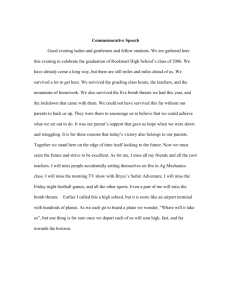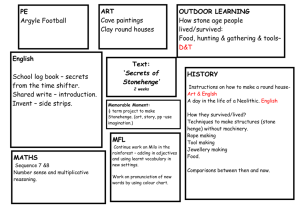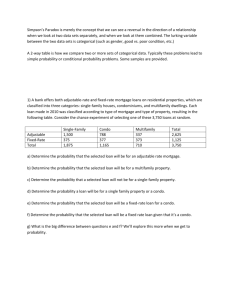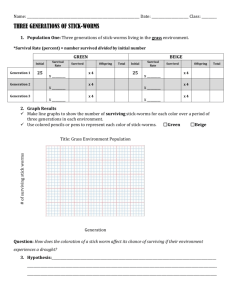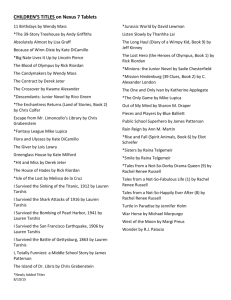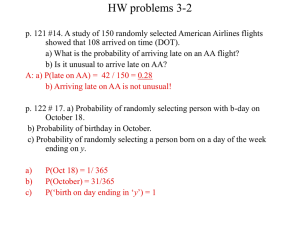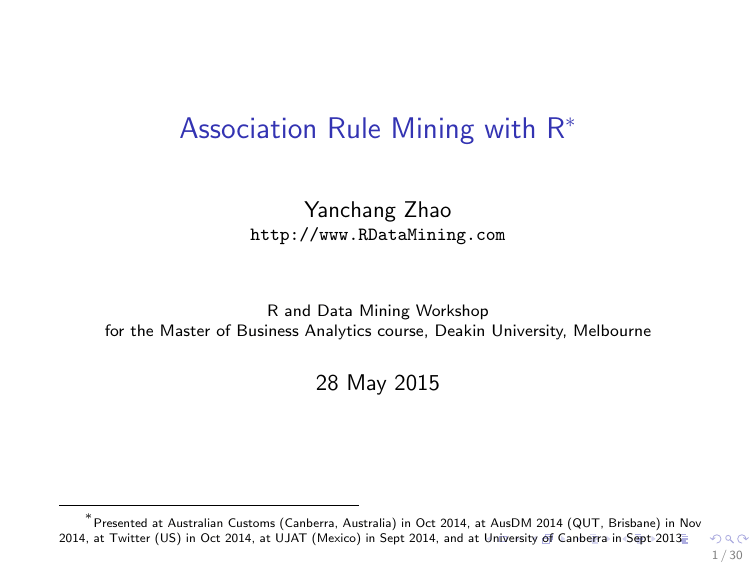
Association Rule Mining with R∗
Yanchang Zhao
http://www.RDataMining.com
R and Data Mining Workshop
for the Master of Business Analytics course, Deakin University, Melbourne
28 May 2015
∗
Presented at Australian Customs (Canberra, Australia) in Oct 2014, at AusDM 2014 (QUT, Brisbane) in Nov
2014, at Twitter (US) in Oct 2014, at UJAT (Mexico) in Sept 2014, and at University of Canberra in Sept 2013
1 / 30
Outline
Introduction
Association Rule Mining
Removing Redundancy
Interpreting Rules
Visualizing Association Rules
Further Readings and Online Resources
2 / 30
Association Rule Mining with R
†
I
basic concepts of association rules
I
association rules mining with R
I
pruning redundant rules
I
interpreting and visualizing association rules
I
recommended readings
†
Chapter 9: Association Rules, R and Data Mining: Examples and Case
Studies. http://www.rdatamining.com/docs/RDataMining.pdf
3 / 30
Association Rules
Association rules are rules presenting association or correlation
between itemsets.
support(A ⇒ B) = P(A ∪ B)
confidence(A ⇒ B) = P(B|A)
P(A ∪ B)
=
P(A)
confidence(A ⇒ B)
lift(A ⇒ B) =
P(B)
P(A ∪ B)
=
P(A)P(B)
where P(A) is the percentage (or probability) of cases containing
A.
4 / 30
Association Rule Mining Algorithms in R
I
APRIORI
I
I
I
a level-wise, breadth-first algorithm which counts transactions
to find frequent itemsets and then derive association rules from
them
apriori() in package arules
ECLAT
I
I
finds frequent itemsets with equivalence classes, depth-first
search and set intersection instead of counting
eclat() in the same package
5 / 30
Outline
Introduction
Association Rule Mining
Removing Redundancy
Interpreting Rules
Visualizing Association Rules
Further Readings and Online Resources
6 / 30
The Titanic Dataset
I
The Titanic dataset in the datasets package is a 4-dimensional
table with summarized information on the fate of passengers
on the Titanic according to social class, sex, age and survival.
I
To make it suitable for association rule mining, we reconstruct
the raw data as titanic.raw, where each row represents a
person.
I
The reconstructed raw data can also be downloaded at
http://www.rdatamining.com/data/titanic.raw.rdata.
7 / 30
load("./data/titanic.raw.rdata")
## draw a sample of 5 records
idx <- sample(1:nrow(titanic.raw), 5)
titanic.raw[idx, ]
##
##
##
##
##
##
1203
1218
1674
941
820
Class
Crew
Crew
3rd
Crew
Crew
Sex
Male
Male
Male
Male
Male
Age Survived
Adult
No
Adult
No
Adult
Yes
Adult
No
Adult
No
summary(titanic.raw)
##
##
##
##
##
Class
1st :325
2nd :285
3rd :706
Crew:885
Sex
Female: 470
Male :1731
Age
Adult:2092
Child: 109
Survived
No :1490
Yes: 711
8 / 30
Function apriori()
Mine frequent itemsets, association rules or association hyperedges
using the Apriori algorithm. The Apriori algorithm employs
level-wise search for frequent itemsets.
Default settings:
I
minimum support: supp=0.1
I
minimum confidence: conf=0.8
I
maximum length of rules: maxlen=10
9 / 30
library(arules)
rules.all <- apriori(titanic.raw)
##
##
##
##
##
##
##
##
##
##
##
##
##
##
##
##
##
##
##
##
Parameter specification:
confidence minval smax arem aval originalSupport support
0.8
0.1
1 none FALSE
TRUE
0.1
minlen maxlen target
ext
1
10 rules FALSE
Algorithmic control:
filter tree heap memopt load sort verbose
0.1 TRUE TRUE FALSE TRUE
2
TRUE
apriori - find association rules with the apriori algorithm
version 4.21 (2004.05.09)
(c) 1996-2004
Christian ...
set item appearances ...[0 item(s)] done [0.00s].
set transactions ...[10 item(s), 2201 transaction(s)] done ...
sorting and recoding items ... [9 item(s)] done [0.00s].
creating transaction tree ... done [0.00s].
checking subsets of size 1 2 3 4 done [0.00s].
writing ... [27 rule(s)] done [0.00s].
creating S4 object ... done [0.00s].
10 / 30
inspect(rules.all)
##
##
##
##
##
##
##
##
##
##
##
##
##
##
##
##
##
##
##
##
##
##
1
2
3
4
5
6
7
8
9
10
11
12
13
14
15
16
lhs
{}
{Class=2nd}
{Class=1st}
{Sex=Female}
{Class=3rd}
{Survived=Yes}
{Class=Crew}
{Class=Crew}
{Survived=No}
{Survived=No}
{Sex=Male}
{Sex=Female,
Survived=Yes}
{Class=3rd,
Sex=Male}
{Class=3rd,
Survived=No}
{Class=3rd,
Sex=Male}
{Sex=Male,
Survived=Yes}
support confidence
...
0.9504771 0.9504771 1.0...
0.1185825 0.9157895 0.9...
0.1449341 0.9815385 1.0...
0.1930940 0.9042553 0.9...
0.2848705 0.8881020 0.9...
0.2971377 0.9198312 0.9...
0.3916402 0.9740113 1.2...
0.4020900 1.0000000 1.0...
0.6197183 0.9154362 1.1...
0.6533394 0.9651007 1.0...
0.7573830 0.9630272 1.0...
...
=> {Age=Adult}
0.1435711 0.9186047 0.9...
...
=> {Survived=No} 0.1917310 0.8274510 1.2...
...
=> {Age=Adult}
0.2162653 0.9015152 0.9...
...
=> {Age=Adult}
0.2099046 0.9058824 0.9...
...
=> {Age=Adult}
0.1535666 0.9209809 0.9...
=>
=>
=>
=>
=>
=>
=>
=>
=>
=>
=>
rhs
{Age=Adult}
{Age=Adult}
{Age=Adult}
{Age=Adult}
{Age=Adult}
{Age=Adult}
{Sex=Male}
{Age=Adult}
{Sex=Male}
{Age=Adult}
{Age=Adult}
11 / 30
# rules with rhs containing "Survived" only
rules <- apriori(titanic.raw,
control = list(verbose=F),
parameter = list(minlen=2, supp=0.005, conf=0.8),
appearance = list(rhs=c("Survived=No",
"Survived=Yes"),
default="lhs"))
## keep three decimal places
quality(rules) <- round(quality(rules), digits=3)
## order rules by lift
rules.sorted <- sort(rules, by="lift")
12 / 30
inspect(rules.sorted)
##
##
##
##
##
##
##
##
##
##
##
##
##
##
##
##
##
##
##
##
##
##
1
2
3
4
5
6
7
8
9
lhs
{Class=2nd,
Age=Child}
{Class=2nd,
Sex=Female,
Age=Child}
{Class=1st,
Sex=Female}
{Class=1st,
Sex=Female,
Age=Adult}
{Class=2nd,
Sex=Female}
{Class=Crew,
Sex=Female}
{Class=Crew,
Sex=Female,
Age=Adult}
{Class=2nd,
Sex=Female,
Age=Adult}
{Class=2nd,
rhs
support confidence
lift
=> {Survived=Yes}
0.011
1.000 3.096
=> {Survived=Yes}
0.006
1.000 3.096
=> {Survived=Yes}
0.064
0.972 3.010
=> {Survived=Yes}
0.064
0.972 3.010
=> {Survived=Yes}
0.042
0.877 2.716
=> {Survived=Yes}
0.009
0.870 2.692
=> {Survived=Yes}
0.009
0.870 2.692
=> {Survived=Yes}
0.036
0.860 2.663
13 / 30
Outline
Introduction
Association Rule Mining
Removing Redundancy
Interpreting Rules
Visualizing Association Rules
Further Readings and Online Resources
14 / 30
Redundant Rules
inspect(rules.sorted[1:2])
##
lhs
rhs
support confidence lift
## 1 {Class=2nd,
##
Age=Child} => {Survived=Yes}
0.011
1 3.096
## 2 {Class=2nd,
##
Sex=Female,
##
Age=Child} => {Survived=Yes}
0.006
1 3.096
I
Rule #2 provides no extra knowledge in addition to rule #1,
since rules #1 tells us that all 2nd-class children survived.
I
When a rule (such as #2) is a super rule of another rule (#1)
and the former has the same or a lower lift, the former rule
(#2) is considered to be redundant.
I
Other redundant rules in the above result are rules #4, #7
and #8, compared respectively with #3, #6 and #5.
15 / 30
Remove Redundant Rules
## find redundant rules
subset.matrix <- is.subset(rules.sorted, rules.sorted)
subset.matrix[lower.tri(subset.matrix, diag = T)] <- NA
redundant <- colSums(subset.matrix, na.rm = T) >= 1
## which rules are redundant
which(redundant)
## [1] 2 4 7 8
## remove redundant rules
rules.pruned <- rules.sorted[!redundant]
16 / 30
Remaining Rules
inspect(rules.pruned)
##
##
##
##
##
##
##
##
##
##
##
##
##
##
##
##
##
##
##
lhs
1 {Class=2nd,
Age=Child}
2 {Class=1st,
Sex=Female}
3 {Class=2nd,
Sex=Female}
4 {Class=Crew,
Sex=Female}
5 {Class=2nd,
Sex=Male,
Age=Adult}
6 {Class=2nd,
Sex=Male}
7 {Class=3rd,
Sex=Male,
Age=Adult}
8 {Class=3rd,
Sex=Male}
rhs
support confidence
lift
=> {Survived=Yes}
0.011
1.000 3.096
=> {Survived=Yes}
0.064
0.972 3.010
=> {Survived=Yes}
0.042
0.877 2.716
=> {Survived=Yes}
0.009
0.870 2.692
=> {Survived=No}
0.070
0.917 1.354
=> {Survived=No}
0.070
0.860 1.271
=> {Survived=No}
0.176
0.838 1.237
=> {Survived=No}
0.192
0.827 1.222
17 / 30
Outline
Introduction
Association Rule Mining
Removing Redundancy
Interpreting Rules
Visualizing Association Rules
Further Readings and Online Resources
18 / 30
inspect(rules.pruned[1])
##
lhs
rhs
support confidence lift
## 1 {Class=2nd,
##
Age=Child} => {Survived=Yes}
0.011
1 3.096
Did children of the 2nd class have a higher survival rate than other
children?
19 / 30
inspect(rules.pruned[1])
##
lhs
rhs
support confidence lift
## 1 {Class=2nd,
##
Age=Child} => {Survived=Yes}
0.011
1 3.096
Did children of the 2nd class have a higher survival rate than other
children?
The rule states only that all children of class 2 survived, but
provides no information at all to compare the survival rates of
different classes.
19 / 30
Rules about Children
rules <- apriori(titanic.raw, control = list(verbose=F),
parameter = list(minlen=3, supp=0.002, conf=0.2),
appearance = list(default="none", rhs=c("Survived=Yes"),
lhs=c("Class=1st", "Class=2nd", "Class=3rd",
"Age=Child", "Age=Adult")))
rules.sorted <- sort(rules, by="confidence")
inspect(rules.sorted)
##
##
##
##
##
##
##
##
##
##
##
##
##
lhs
1 {Class=2nd,
Age=Child}
2 {Class=1st,
Age=Child}
3 {Class=1st,
Age=Adult}
4 {Class=2nd,
Age=Adult}
5 {Class=3rd,
Age=Child}
6 {Class=3rd,
Age=Adult}
rhs
support confidence
=> {Survived=Yes} 0.010904134
1.0000000
=> {Survived=Yes} 0.002726034
1.0000000
=> {Survived=Yes} 0.089504771
0.6175549
=> {Survived=Yes} 0.042707860
0.3601533
=> {Survived=Yes} 0.012267151
0.3417722
=> {Survived=Yes} 0.068605179
0.2408293
...
...
3.09...
...
3.09...
...
1.91...
...
1.11...
...
1.05...
...
0.74...
20 / 30
Outline
Introduction
Association Rule Mining
Removing Redundancy
Interpreting Rules
Visualizing Association Rules
Further Readings and Online Resources
21 / 30
library(arulesViz)
plot(rules.all)
Scatter plot for 27 rules
1
1.25
1.2
0.95
confidence
1.15
1.1
0.9
1.05
0.85
1
0.95
0.2
0.4
0.6
support
0.8
lift
22 / 30
LHS
{Class=3rd} − 1 rules
{Class=3rd, +1 items} − 1 rules
{Sex=Female} − 1 rules
{Class=2nd} − 1 rules
{Class=3rd, +2 items} − 1 rules
{Sex=Female, +1 items} − 1 rules
{Survived=Yes, +1 items} − 2 rules
{Class=1st} − 1 rules
{Sex=Male} − 1 rules
{Class=1st, +2 items} − 2 rules
{Class=3rd, +2 items} − 1 rules
{Class=Crew, +2 items} − 2 rules
{Class=3rd, +1 items} − 2 rules
{Survived=No} − 2 rules
{Class=Crew} − 2 rules
{Class=Crew, +1 items} − 2 rules
{Age=Adult, +1 items} − 1 rules
{Class=3rd, +2 items} − 1 rules
{Class=Crew, +1 items} − 1 rules
{Class=Crew, +2 items} − 1 rules
plot(rules.all, method = "grouped")
Grouped matrix for 27 rules
size: support
color: lift
{Sex=Male}
RHS
{Survived=No}
{Age=Adult}
23 / 30
plot(rules.all, method = "graph")
Graph for 27 rules
size: support (0.119 − 0.95)
color: lift (0.934 − 1.266)
Class=1st
Class=3rd
Survived=No
Sex=Male
Class=Crew
Age=Adult
Class=2nd
Sex=Female
Survived=Yes
24 / 30
plot(rules.all, method = "graph", control = list(type = "items"))
Graph for 27 rules
size: support (0.119 − 0.95)
color: lift (0.934 − 1.266)
Sex=Female
Survived=Yes
Class=1st
Class=2nd
Age=Adult
Class=Crew
Sex=Male
Survived=No
Class=3rd
25 / 30
plot(rules.all, method = "paracoord", control = list(reorder = TRUE))
Parallel coordinates plot for 27 rules
Class=Crew
Class=2nd
Survived=Yes
Survived=No
Sex=Male
Class=1st
Class=3rd
Age=Adult
Sex=Female
3
2
1
rhs
Position
26 / 30
Outline
Introduction
Association Rule Mining
Removing Redundancy
Interpreting Rules
Visualizing Association Rules
Further Readings and Online Resources
27 / 30
Further Readings
I
More than 20 interestingness measures, such as chi-square,
conviction, gini and leverage
Tan, P.-N., Kumar, V., and Srivastava, J. (2002). Selecting the right
interestingness measure for association patterns. In Proc. of KDD ’02,
pages 32-41, New York, NY, USA. ACM Press.
I
Post mining of association rules, such as selecting interesting
association rules, visualization of association rules and using
association rules for classification
Yanchang Zhao, Chengqi Zhang and Longbing Cao (Eds.). “Post-Mining
of Association Rules: Techniques for Effective Knowledge Extraction”,
ISBN 978-1-60566-404-0, May 2009. Information Science Reference.
I
Package arulesSequences: mining sequential patterns
http://cran.r-project.org/web/packages/arulesSequences/
28 / 30
Online Resources
I
Chapter 9: Association Rules, in book
R and Data Mining: Examples and Case Studies
http://www.rdatamining.com/docs/RDataMining.pdf
I
R Reference Card for Data Mining
http://www.rdatamining.com/docs/R-refcard-data-mining.pdf
I
Free online courses and documents
http://www.rdatamining.com/resources/
I
RDataMining Group on LinkedIn (12,000+ members)
http://group.rdatamining.com
I
RDataMining on Twitter (2,000+ followers)
@RDataMining
29 / 30
The End
Thanks!
Email: yanchang(at)rdatamining.com
30 / 30

